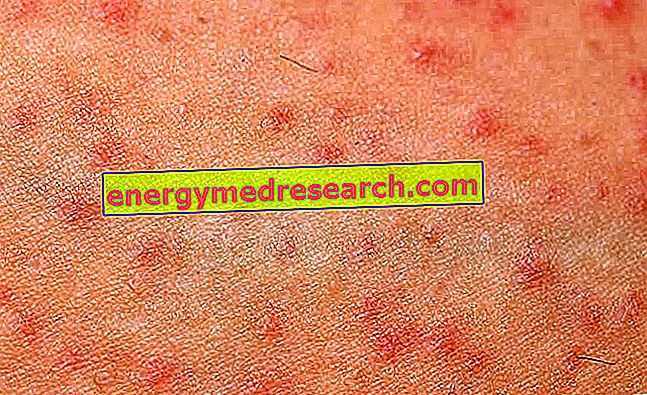What is the Folliculitis
The term folliculitis refers to a generic inflammation of the hair follicles. Fortunately, a mild disorder, the superficial folliculitis begins with small spots in relief, filled with pus, which resemble small pimples. Generally, the folliculitis manifests itself rather lightly; therefore, skin lesions resolve spontaneously over a short period. Other types of folliculitis, on the other hand, turn out to be more severe, causing damage such as to require the use of antibiotic and / or cortisone creams.
In general, folliculitis can have an infectious origin - therefore be caused by bacterial, viral or fungal infections - or non-infectious, induced therefore by other causes.

Infectious folliculitis
There are different forms of infectious folliculitis, which differ mainly based on the causative agent (causal):
- Bacterial folliculitis (the most frequent form): typical infection that occurs immediately after epilation treatments (eg laser) and depilatories (simple shaving), or after mechanical injuries or chemical trauma at the level of the skin responsible for the deformation of the hair shaft
- Fungal folliculitis, is almost always caused by direct contact with objects or surfaces infected with fungi, such as common showers and changing rooms
- Viral folliculitis, typical of the area surrounding the lips
Based on the triggering pathogen and the characteristic symptoms, each type of infectious folliculitis is divided into several sub-categories. Let's look at the main features, shown in the following table.
| Bacterial folliculitis | ||
| TRAINING PATHOGEN | NAME OF FOLLICOLITE | GENERALITY? |
| Staphylococcus aureus | Sicosi of beard or sicosi vulgaris | The beard sycosis is a type of male folliculitis that involves the facial area (cheeks and chin). At the level of the lip contour, the affected patient complains of symptoms such as itching and burning, which tend to get worse after a simple shave. When it appears at the level of the hair, this type of folliculitis causes numerous pustules which, besides being annoying, are rather unsightly. |
| Staphylococcus aureus | Honeycomb-Charcoal (not to be confused with anthrax) | Involving a group of follicles, carbuncle can also be considered a type of folliculitis caused exclusively by a staphylococcal infection. The infection sustained by this pathogen causes painful pus-filled skin blisters. |
| Staphylococcus aureus | Searing Folliculitis | It is a deep staphylococcal folliculitis that affects the scalp, characterized by the formation of pustules that tend to clump together and lead to hair loss. We therefore witness the formation of alopecic patches associated with the literal destruction of the hair follicle. The therapy of decalvenous folliculitis is based on the use of topical or systemic antibiotics, such as, for example, clindamycin, rifampicin or flucloxacillin. |
| Pseudomonas aeruginosa | "HOT-TUB" folliculitis (the so-called whirlpool bath folliculitis) | The bizarre name of this type of folliculitis is reminiscent of the way in which the infection is transmitted: the "HOT-TUB" folliculitis tends to manifest itself after a bath in a not carefully sanitized whirlpool or with a low concentration of chlorine. The hot and unhygienic water of the hot tub encourages the development of P. aeruginosa, which in turn increases the risk of folliculitis. Generally, this type of superficial infection involves the legs, buttocks, hips and surrounding areas. |
| Gram negative in general, such as: Escherichia coli, Serratia marcescens, Klebsiella and Proteus mirabilis | - | Typically, this form of folliculitis manifests itself after long-term treatment with antibiotics taken to treat severe acne. |
| Viral folliculitis | ||
| TRAINING PATHOGEN | NAME OF FOLLICOLITE | GENERALITY? |
| Herpes Simplex Virus | Herpetic folliculitis | It usually occurs when a pre-existing labial herpes infection spreads to the neighboring hair follicles. |
| Fungal Folliculitis | ||
| TRAINING PATHOGEN | NAME OF FOLLICOLITE | GENERALITY? |
| Trichophyton rubrum | Tinea barbae | It is a folliculitis that typically affects the beard follicles; this type of folliculitis - which therefore occurs exclusively in humans - produces small pustules at the level of the chin, jaw and upper lip. The disorder worsens with shaving. |
| Candida albicans | Candida folliculitis | It is a form of folliculitis that generally affects the shoulders, chest and face. The same disorder was observed with a higher incidence in patients treated with corticosteroid drugs. |
| Mushrooms of the genus Malassezia | Malassezia folliculitis or Pityrosporum folliculitis | Responsible for unsightly and annoying chronic pustules on the back, chest and neck, this type of folliculitis tends to occur mainly among adolescents and young adults. |
Non-infectious folliculitis
Not all types of folliculitis are caused by infections; in fact, there are some variants that have nothing to do with infectious insults. Immunocompromised patients, suffering from obesity or dermatosis, and showing evident skin lesions are actually more at risk of folliculitis than healthy people.

Tufted Folliculitis
The tufted folliculitis - also known as doll hair folliculitis - is a variety of decalvenous folliculitis, therefore typical of the scalp. It is characterized by the formation of pustules and inflamed areas in which there are tufts of hair that emerge from the same follicular ostium (hence the name of tufted folliculitis). Unfortunately, the course of this form of folliculitis is chronic-relapsing and tends to evolve into a sort of cicatricial alopecia.
Indeed, inserting the tufted folliculitis between the non-infectious folliculitis would not be entirely correct, since, in most cases, it appears to be secondary to a staphylococcal infection. However, it has been observed that tufted folliculitis is not exclusively related to staphylococcal infections, but can also be the consequence of other inflammatory scalp pathologies which then lead to cicatricial alopecia.
Given the uncertainty of the triggering cause, the treatment of this form of folliculitis is rather difficult and often disappointing. However, if the presence of an ongoing Staphylococcus aureus infection is detected, the therapy that is usually undertaken is the same as that described for the decalvenous folliculitis.
Cheloidea folliculitis
Cheloid folliculitis - also known as cheloid acne of the neck - is a form of folliculitis typical of males with curly hair. It is characterized by the formation of papules, pustules and crusts behind the neck (nape) which then lead to the formation of keloid scars (from which the disorder is named).
Unfortunately, currently available therapies are not able to solve the problem completely. In some cases, laser therapy or cryotherapy with liquid nitrogen may be useful, but the use of this type of treatment may not be indicated for all patients. For this reason, the doctor will have to decide on a strictly individual basis which therapeutic strategy to adopt.
Eosinophilic Folliculitis
Eosinophilic folliculitis is a type of folliculitis characteristic of severely immunocompromised patients, such as those with AIDS. This form of folliculitis manifests itself with the formation of lesions rich in pus, particularly itchy, which appear above all in the face, shoulders and forearm.
Eosinophilic folliculitis is characterized by the fact that it occurs in association with eosinophilia, that is, in association with an increase in the number of eosinophils in peripheral blood.
However, it is important to remember that - although it has been observed with greater incidence in AIDS patients - eosinophilic folliculitis can also occur in infants, newborns and healthy adults. In this regard, it is therefore possible to distinguish three different forms: the eosinophilic folliculitis during AIDS, the eosinophilic folliculitis of the infant and the eosinophilic folliculitis of the adult (in health).
pseudofolliculitis
As you can easily guess from its very name, in this case it is not a real folliculitis, since the pimples that are formed do not contain pus. In reality, pseudofollicolite is nothing but the consequence of ingrown hairs. This type of folliculitis, typical of people with curly hair and African-Americans, can also cause scarring on the skin. One of the most well-known forms, certainly, is that which occurs in men at the level of the beard and which is commonly defined as shaving pseudofollicolite, or irritative shaving folliculitis.



